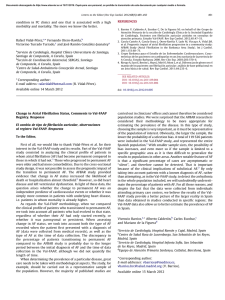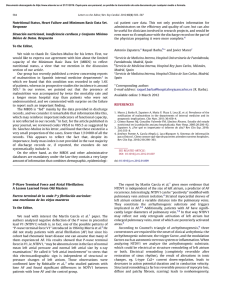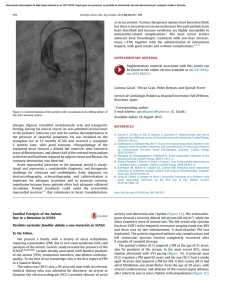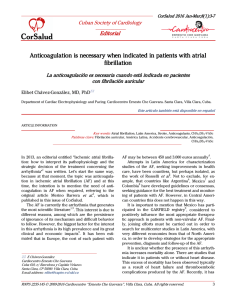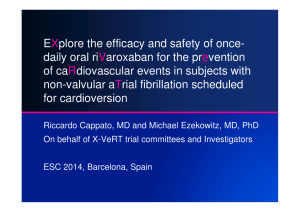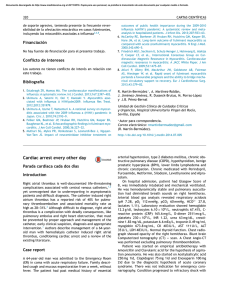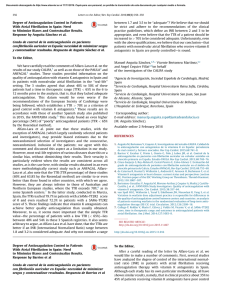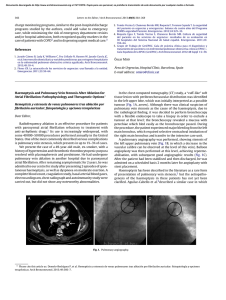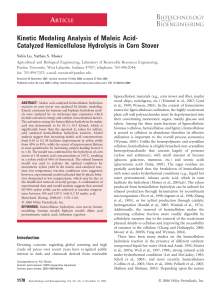Predictors of success and effect of biphasic energy on
Anuncio
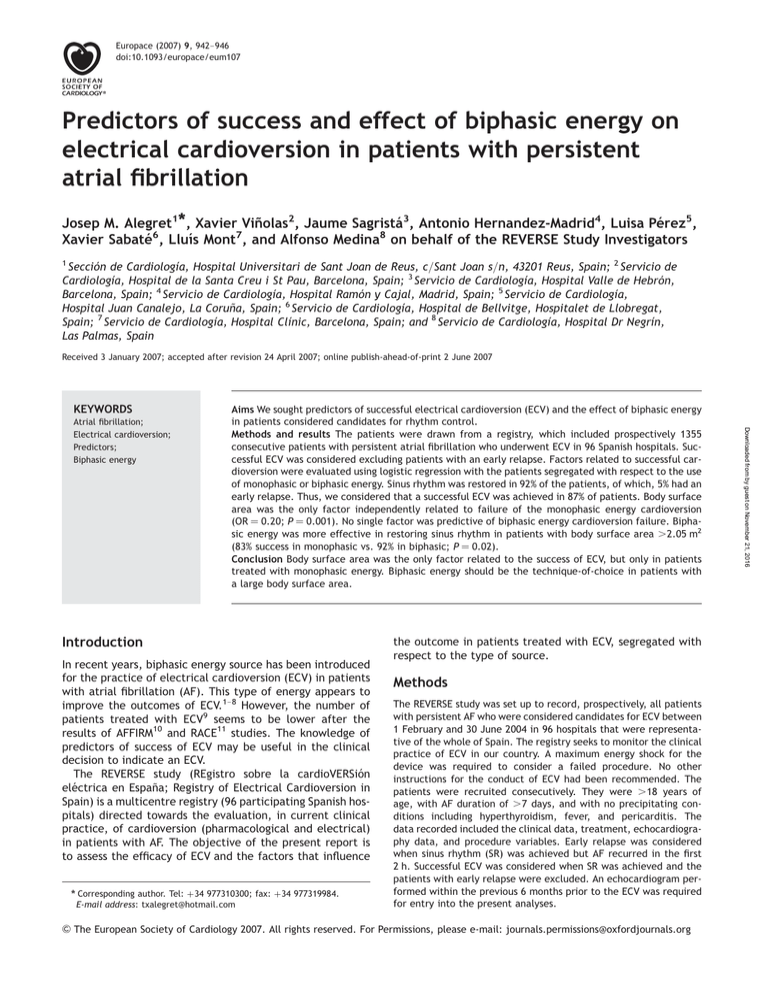
Europace (2007) 9, 942–946 doi:10.1093/europace/eum107 Predictors of success and effect of biphasic energy on electrical cardioversion in patients with persistent atrial fibrillation Josep M. Alegret1*, Xavier Viñolas2, Jaume Sagristá3, Antonio Hernandez-Madrid4, Luisa Pérez5, Xavier Sabaté6, Lluı́s Mont7, and Alfonso Medina8 on behalf of the REVERSE Study Investigators 1 Sección de Cardiologı́a, Hospital Universitari de Sant Joan de Reus, c/Sant Joan s/n, 43201 Reus, Spain; 2 Servicio de Cardiologı́a, Hospital de la Santa Creu i St Pau, Barcelona, Spain; 3 Servicio de Cardiologı́a, Hospital Valle de Hebrón, Barcelona, Spain; 4 Servicio de Cardiologı́a, Hospital Ramón y Cajal, Madrid, Spain; 5 Servicio de Cardiologı́a, Hospital Juan Canalejo, La Coruña, Spain; 6 Servicio de Cardiologı́a, Hospital de Bellvitge, Hospitalet de Llobregat, Spain; 7 Servicio de Cardiologı́a, Hospital Clı́nic, Barcelona, Spain; and 8 Servicio de Cardiologı́a, Hospital Dr Negrı́n, Las Palmas, Spain Received 3 January 2007; accepted after revision 24 April 2007; online publish-ahead-of-print 2 June 2007 KEYWORDS Aims We sought predictors of successful electrical cardioversion (ECV) and the effect of biphasic energy in patients considered candidates for rhythm control. Methods and results The patients were drawn from a registry, which included prospectively 1355 consecutive patients with persistent atrial fibrillation who underwent ECV in 96 Spanish hospitals. Successful ECV was considered excluding patients with an early relapse. Factors related to successful cardioversion were evaluated using logistic regression with the patients segregated with respect to the use of monophasic or biphasic energy. Sinus rhythm was restored in 92% of the patients, of which, 5% had an early relapse. Thus, we considered that a successful ECV was achieved in 87% of patients. Body surface area was the only factor independently related to failure of the monophasic energy cardioversion (OR ¼ 0.20; P ¼ 0.001). No single factor was predictive of biphasic energy cardioversion failure. Biphasic energy was more effective in restoring sinus rhythm in patients with body surface area .2.05 m2 (83% success in monophasic vs. 92% in biphasic; P ¼ 0.02). Conclusion Body surface area was the only factor related to the success of ECV, but only in patients treated with monophasic energy. Biphasic energy should be the technique-of-choice in patients with a large body surface area. Introduction In recent years, biphasic energy source has been introduced for the practice of electrical cardioversion (ECV) in patients with atrial fibrillation (AF). This type of energy appears to improve the outcomes of ECV.1–8 However, the number of patients treated with ECV9 seems to be lower after the results of AFFIRM10 and RACE11 studies. The knowledge of predictors of success of ECV may be useful in the clinical decision to indicate an ECV. The REVERSE study (REgistro sobre la cardioVERSión eléctrica en España; Registry of Electrical Cardioversion in Spain) is a multicentre registry (96 participating Spanish hospitals) directed towards the evaluation, in current clinical practice, of cardioversion (pharmacological and electrical) in patients with AF. The objective of the present report is to assess the efficacy of ECV and the factors that influence * Corresponding author. Tel: þ34 977310300; fax: þ34 977319984. E-mail address: [email protected] the outcome in patients treated with ECV, segregated with respect to the type of source. Methods The REVERSE study was set up to record, prospectively, all patients with persistent AF who were considered candidates for ECV between 1 February and 30 June 2004 in 96 hospitals that were representative of the whole of Spain. The registry seeks to monitor the clinical practice of ECV in our country. A maximum energy shock for the device was required to consider a failed procedure. No other instructions for the conduct of ECV had been recommended. The patients were recruited consecutively. They were .18 years of age, with AF duration of .7 days, and with no precipitating conditions including hyperthyroidism, fever, and pericarditis. The data recorded included the clinical data, treatment, echocardiography data, and procedure variables. Early relapse was considered when sinus rhythm (SR) was achieved but AF recurred in the first 2 h. Successful ECV was considered when SR was achieved and the patients with early relapse were excluded. An echocardiogram performed within the previous 6 months prior to the ECV was required for entry into the present analyses. & The European Society of Cardiology 2007. All rights reserved. For Permissions, please e-mail: [email protected] Downloaded from by guest on November 21, 2016 Atrial fibrillation; Electrical cardioversion; Predictors; Biphasic energy Predictors of success and effect of biphasic energy Statistical analyses Qualitative variables are expressed in percentages and the differences were assessed using the x2 test. Quantitative variables are presented as the mean + standard deviation (SD) and the differences were evaluated using the Student’s t-test. A logistic multivariate regression analysis was performed to identify the independent variables related to the success of ECV. The variables included in the multivariate analysis were those that had a significance of P , 0.10 in the univariate analysis. Statistical significance was accepted at P , 0.05. All analyses were performed with the SPSS statistical software package (version 12). Results Table 1 Clinical and echocardiography characteristics of the patients from REVERSE registry Characteristics n (%) or mean + SD Age (years) Male gender Hypertension Diabetes mellitus Chronic pulmonary disease Cardiomyopathy Valvular heart disease Coronary artery disease Previous embolism No underlying heart disease Duration of AF .6 months Functional class NYHA I II III–IV Left atrial size (mm) Left atrial size (qualitative) 40 mm 41–45 mm 46–55 mm .55 mm LVEF (%) (n ¼ 1290) LVEF (qualitative) (n ¼ 1290) (%) EF 50 EF 40–49 EF 30–39 EF ,30 Left ventricle hypertrophy Mild Moderate—notable 63 + 11 875 (65) 751 (55) 205 (15) 119 (9) 106 (8) 223 (13) 122 (9) 62 (5) 651 (48) 346 (26) LVEF, left ventricular ejection fraction. 702 (52) 560 (41) 93 (7) 44.6 + 6.3 350 (25) 484 (36) 456 (34) 65 (5) 58.6 + 11.6 1144 (84) 114 (9) 66 (5) 31 (2) 317 (23) 202 (15) We analysed the clinical and echocardiographic characteristics related to the success of ECV. Gender, weight, height, and body surface area (BSA) were related to successful ECV (Table 2). In the multivariate analysis, BSA (OR ¼ 0.23; P ¼ 0.001) was the only variable significantly related to the outcome. When we compared the characteristics of patients treated with monophasic or biphasic source, patients treated with biphasic source were younger; had slightly larger BSA, height, and weight; had more diabetes and AF longer than 6 months; received less previous anti-arrythmic treatment; and were treated more frequently with anteroposterior pads. The left atrial diameter was slightly larger in the monophasic source group, but the number of patients with a diameter larger than 50 mm was similar in both groups. The rest of the clinical and echocardiographic characteristics were similar in both groups (Table 3). Biphasic source tended to be more effective in restoring SR than monophasic source (monophasic 91% vs. biphasic 94%; P ¼ 0.05). The number of patients with early relapse was similar in both groups (monophasic 5.3% vs. biphasic 6%; P ¼ 0.7). The energy required to achieve SR was lower with biphasic source than with monophasic source (161 + 78 vs. 266 + 78; P ¼ 0.0001), with a similar number of shocks required to be administered in both groups (1.5 + 0.8 vs. 1.6 + 0.8; P ¼ 0.6). An initial maximum energy was more frequently used in the biphasic than in the monophasic source group [39 patients (5.7%) vs. 75 patients (11.2%); P ¼ 0.01]. We evaluated the factors related to success of ECV segregated with respect to the type of source. With monophasic source, the univariate analysis indicated that the same variables (gender, weight, height, and BSA) were related to the success of ECV whereas BSA (OR ¼ 0.20; P ¼ 0.001) maintained its independent relationship. When we analysed the patients treated with biphasic source, no single factor was related to success of ECV. When we selected patients with BSA .2.05 m2, which corresponded to the fourth quartile of the BSA distribution and studied the factors related to the success of ECV, more patients reverted to SR (83% monophasic vs. 92% biphasic; P ¼ 0.02) and ECV was considered successful (excluding early relapse) in more patients when biphasic source was administered compared with monophasic source (n ¼ 285; 75% monophasic vs. 84% biphasic; P ¼ 0.048). In those patients, biphasic energy was the only predictor of success in the univariate and in the multivariate analysis (OR ¼ 1.83, P ¼ 0.04). We did not find significant differences in the clinical and echocardiographic characteristics among patients with BSA .2.05 m2 treated with biphasic or monophasic energy shock. Discussion We observed that, in a wide non-selected group of patients with persistent AF, ECV was highly effective in restoring SR. BSA was related to the success of ECV in patients treated with monophasic source, whereas none of the factors we had considered were related to outcome in patients treated with biphasic source. Biphasic source was more effective than monophasic source in patients with high BSA. Results of previous studies seeking factors predictive of success of ECV included different types of AF and most of the studies had been conducted over a wide time range. Downloaded from by guest on November 21, 2016 There were 1355 consecutive patients with persistent AF in whom there had been an attempt at ECV. Table 1 summarizes the clinical characteristics of the patients. There were 55% who were hypertensive and 15% were diabetic. Half the number of patients had structural heart disease. A great majority of the patients (84%) had normal systolic function and 75% had normal-sized left atrium. Half the number of patients had received monophasic shock (n ¼ 684; 50.5%) and the other half (n ¼ 671; 49.5%) had received biphasic shock treatment. The ECV restored SR in 1251 patients (92%). There were 76 patients (5%) who had an early relapse. As such, a successful ECV was achieved in a total of 1175 patients (87%). 943 944 J.M. Alegret et al. Table 2 Variables related to successful electrical cardioversion Factors Success (n ¼ 1175) Failure (n ¼ 180) P-value Age (years) Male gender Weight (kg) Height (cm) Body surface area (m2) Hypertension Chronic pulmonary disease Diabetes mellitus Structural heart disease Left atrial size Left atrial dilatation (.50 mm) LVEF (%) LVEF ,50% Previous electrical cardioversion Duration of AF .1 year ACE-I/ARB Previous anti-arrhythmic treatment Anteroposterior pads Biphasic energy 63 + 11 739 (63) 79 + 13 167 + 9 1.91 + 0.19 656 (56) 105 (9) 179 (15) 614 (52) 44.6 + 6.3 225 (19) 59 + 12 178 (15) 239 (20) 138 (12) 620 (53) 422 (36) 432 (37) 589 (50) 61 + 12 136 (76) 83 + 14 169 + 9 1.96 + 0.19 95 (53) 14 (8) 26 (14) 90 (50) 44.7 + 6.8 34 (19) 57 + 12 33 (18) 40 (22) 29 (16) 89 (49) 57 (32) 71 (39) 82 (46) 0.03 0.001 0.002 0.01 0.001 0.44 0.61 0.78 0.57 0.90 0.99 0.15 0.14 0.55 0.10 0.41 0.27 0.50 0.25 Values are n (%) or mean + SD. AF, atrial fibrillation; LVEF, left ventricular ejection fraction; ACE-I, angiotensinconverting enzyme inhibitor; ARB, angiotensin II receptor blockers. Factors Monophasic (n ¼ 684) Biphasic (n ¼ 671) P-value Age (years) Male gender Weight (kg) Height (cm) Body surface area (m2) Hypertension Chronic pulmonary disease Diabetes mellitus Structural heart disease Left atrial size (mm) Left atrial dilatation (.50 mm) LVEF (%) LVEF ,50% Previous electrical cardioversion Duration of AF .1 year ACE-I/ARB Previous anti-arrhythmic treatment Anteroposterior pads 64 + 11 432 (63) 78 + 13 166 + 9 1.90 + 0.15 375 (55) 58 (8) 90 ( 13) 372 (54) 45.2 + 6.2 142 (21) 58.6 + 11.3 107 (16) 151 (22) 72 (11) 369 (54) 262 (39) 209 (31) 62 + 11 443 (66) 81 + 14 168 + 9 1.94 + 0.19 376 (56) 61 (9) 115 (17) 332 (49) 44.3 + 5.4 117 (17) 58.6 + 11.9 104 (16) 128 (19) 95 (14) 340 (51) 217 (32) 294 (44) 0.001 0.27 0.0001 0.002 0.0001 0.65 0.70 0.04 0.15 0.01 0.07 0.98 0.94 0.18 0.04 0.23 0.02 0.0001 Values are n (%) or mean + SD. AF, atrial fibrillation; LVEF, left ventricular ejection fraction; ACE–I, angiotensinconverting enzyme inhibitor; ARB, angiotensin II receptor blockers. The REVERSE registry is unique in that it reflects the results obtained in current clinical practice over a whole country. The efficacy of ECV in our study was very high (92%; 87% excluding early relapse) and is higher than in most published trials. We believe that this may be due to the use of biphasic energy (in approximately half the number of patients in the study) and the characteristics of patients. Also, following the AFFIRM and RACE studies, some data suggest that clinicians appear to be selecting the patients for ECV.9 We observed small differences in some characteristics among the patients treated with biphasic or monophasic energy. One third of centers used both types of energy. This may explain the selection of biphasic energy in younger patients and those with previously described poor predictors, as patients with a larger BSA and longer duration of AF. Weight and BSA should be related with higher prevalence of diabetes. There has been considerable debate in the past few years on the advantages of biphasic energy compared with monophasic energy. Biphasic source results in fewer skin lesions and greater rate of reversion to SR for the same amount of administered energy.1–8 However, increase in efficacy using maximum biphasic energy shock is slightly relative to monophasic shock and is due, in part, to the high efficacy of maximum energy associated with monophasic shocks. Downloaded from by guest on November 21, 2016 Table 3 Clinical and echocardiographic variables, segregated with respect to the type of source Predictors of success and effect of biphasic energy Acknowledgements The study was supported by the Section of Electrophysiology and Arrhythmias of the Sociedad Española de Cardiologı́a. The study was funded, in part, by a non-restricted grant from 3M Farmaceutica Spain. Conflict of interest: none declared. Appendix List of investigators and centres participating in the REVERSE study and priority listed with respect to the numbers of patients recruited L. Pérez; H. Juan Canalejo, Coruña A. Hernández-Madrid; H. Ramón y Cajal, Madrid X. Sabaté; H. de Bellvitge, Hospitalet de Llobregat A. Medina; H. Dr Negrin, Las Palmas L. Mont; H. Clı́nic i Provincial de Barcelona, Barcelona A. Berruezo; H.U. Puerta del Mar, Cádiz A. Moya; H.G.U. Valle de Hebrón, Barcelona J.L. Martı́nez Sande; H.C. Universitario, Santiago A. Pastor; H.U., Getafe A. Grande; H. Severo Ochoa, Leganés J. Villacastı́n; H.C.U.S. Carlos, Madrid J.G. Martinez; H. Gral. U. de Alicante, Alicante L. Azocar; H. Sta Creu i Sant Pau, Barcelona E. Castellanos; H. Virgen de la Salud de Toledo, Toledo N. Pachón; H.U. Central de Asturias, Oviedo F. Crespo; H. Xeral Calde, Lugo F. Freire; H. de Palamós, Palamós J. González Ruiz; H. de Galdakano, Vizcaya J.F. Garcia Sacristán; H. General de Albacete J. Benezet; H. Ntra. Sra Alarcos, Ciudad Real T. Ripio; H. Son Llatzer, Palma de Mallorca A. Asso; H. Miguel Servet, Zaragoza X. Beiras; H. Xeral Cies, Vigo R. Barba; H.J. Ramón Jiménez, Huelva F. Redondo; H. Cristal Piñor, Orense J.R. Casariego; H. Montecelo, Pontevedra L. Tercedor; H. Virgen de las Nieves, Granada J. Delso; H. Creu Roja, Barcelona R. Pavón; H.U. de Valme, Sevilla J. Ormaetxe; H. de Basurto, Bilbao L. Garcia Riesco; H. de RioTinto, Huelva P. Gil; H. Txagorritxu,Vitoria V. Palanca; H. Gral Universitario, Valencia A. Pedrote; H.U. Virgen del Rocio, Sevilla M. Gonzalez; H.U. La Paz, Madrid C. Exposito; H. Son Dureta, Palma de Mallorca C. Ledesma; H.U. de Salamanca E. Gonzalez; H. Gral de Jerez B. Herreros; H. Rio Hortega, Valladolid C. Romero; H. Sant Boi de Llobregat R. Canals; H. Comarcal de Mollet J.R. Carmona; H. de Navarra, Pamplona O. Medina; H.U. Insular de Gran Canaria, Las Palmas J. Olagüe; H.U. La Fe, Valencia P. Carrillo; H.U. de S Juan de Alicante I. Garcia-Bolao; C.U. de Navarra, Pamplona F. Mazuelos; H. Reina Sofia, Córdoba L. Guillamon; H. Gral de Catalunya, St. Cugat del Vallés J. Arana; H. de Cruces, Baracaldo I. Duran; H.U. Sant Joan de Reus J. Pelegrin; C.U. Lozano Blesa, Zaragoza J. Muñoz; H.U. Ciudad de Jaen J. Rubio; H.U. de Valladolid J.M. Gonzalez; H. de León A. Moleiro; H. Gral de Vic M. Anton; H. Torrecárdenas, Almerı́a A. Ardiaca; H. Arnau de Vilanova, Lleida I. Lechuga; H. Verge de la Cinta, Tortosa P. Garcia; H. Gral Sta MarÍa de Rosell, Cartagena A.G. Alberola; H.U. Virgen de La Arrixaca, Murcia A. Rodriguez; H.C.U. de Canarias, La Laguna N. Batalla; H. Sagrat Cor, Barcelona M. Lopez; H.G.U. Gregorio Marañón, Madrid E. Sanz; H.U. Joan XXIII, Tarragona F. del Campo; H. Virgen de la Concha, Zamora I. Fernandez Lozano; C. Puerta de Hierro, Madrid J. Sanchez; H. Rafael Méndez, Lorca F. Lopez; H. de la Ribera, Alzira S. Castillo; H. Germans Trias, Badalona J. de Miguel; H. de Terrassa J.G. Reverte; H. Gral. U. de Murcia J. Alzueta; H.C.U Vigen de la Victoria, Málaga F. Ruiz; H. Costa del Sol, Marbella I. Romeo; H. d’Igualada J.A. Ruiz; H. Gral. U. Morales Meseguer, Murcia G. Vazquez; H. de Sant Jaume, Calella J. Dominguez; H. General Yague, Burgos M. Lopez; H. 12 Octubre, Madrid G. Fernandez; H.U. Infanta Cristina, Badajoz M.L. Moro; H. de Mérida M. Pavon; H.U. Virgen Macarena, Sevilla M. Pujol; H. de Viladecans G. Vazquez; H. Comarcal de la Selva, Blanes J.J. Cortina; H. Gral de Segovia J. Vega; H.S. Pedro de Alcántara, Cáceres J. Vara; H.S. Juan de Dios, León J. Castro; H. General U. de Guadalajara A. Navarro; H. Gral Castellón A. Criado; H. de Móstoles F. Martinez; H. Los Arcos, S Javier C.A. Berrocal, H. Gral Rio Carrión, Palencia A. Descalzi; H. Comarcal Alt Penedés, Vilafranca del Penedés Downloaded from by guest on November 21, 2016 This is the first study that assesses predictors of success of ECV depending on the use of biphasic or monophasic energy. In previous studies, different factors such as duration of the AF episode, age, left atrial size, and body weight have been related to ECV success, but with conflicting results. Duration of AF is one of the most frequently reported. Although short duration AF has been frequently described as a predictor of success, there are discordant data in AF of longer duration.1,3,6,12–16 In our study, BSA was the only variable related to failure of ECV in the group of patients receiving monophasic shocks. In the biphasic group, no factor was predictive of failure, in great part due to the small number of patients that did not revert to SR. In the subgroup of patients with greater BSA, biphasic source was more efficacious than monophasic in achieving SR and the only predictor of success. BSA is related to the volume of the thoracic cavity and, consequently, with the electrical impedance of the thorax.17 Electrical impedance has been described previously as being the limiting factor in the success of ECV.1 Biphasic source overcomes this limitation by adjusting the current administered so as to overcome the electrical impedance. This could explain why BSA does not predict the success in patients treated with biphasic source and why biphasic source would be more efficacious in patients with a higher BSA. Following this reasoning, we would recommend the routine use of biphasic source in patients with high BSA. The high efficacy of biphasic energy (94%) limits the use of internal cardioversion to very specific cases. 945 946 L. Martinez; H.U. de la Princesa, Madrid F. Planas; H. de Badalona E. Cabello; H. Virgen del Puerto, Plasencia J. Viñas; H. Gral Virgen de la Luz, Cuenca J.M. Alegret et al. 9. 10. References 11. 12. 13. 14. 15. 16. 17. Downloaded from by guest on November 21, 2016 1. Mittal S, Ayati S, Stein KM, Schwartzman D, Cavlovich D, Tchou PJ et al. Transthoracic cardioversion of atrial fibrillation. Comparison of rectilinear biphasic versus damped sine wave monophasic shocks. Circulation 2000;101:1282–7. 2. Page RL, Kerber RE, Russell JK, Trouton T, Waktare J, Gallik D et al. for the BiCard Investigators. Biphasic versus monophasic shock waveform for conversion of atrial fibrillation. J Am Coll Cardiol 2002;39:1956–63. 3. Ermis C, Zhu AX, Sinha S, Iskos D, Sakaguchi S, Lurie KG et al. Efficacy of biphasic waveform cardioversion for atrial fibrillation and atrial flutter compared with conventional monophasic waveforms. Am J Cardiol 2002;90:891–2. 4. Scholten M, Szili-Torok T, Klootwijk P, Jordaens L. Comparison of monophasic and biphasic shocks for transthoracic cardioversion of atrial fibrillation. Heart 2003;89:1032–34. 5. Neal S, Ngarmukos T, Lessard D, Rosenthal L. Comparison of the efficacy and safety of two biphasic defibrillator waveforms for the conversion of atrial fibrillation to sinus rhythm. Am J Cardiol 2003;92:810–4. 6. Koster RW, Dorian P, Chapman FW, Schmitt PW, O’Grady SG, Walker RG. A randomized trial comparing monophasic and biphasic waveform shocks for external cardioversion of atrial fibrillation. Am Heart J 2004;147:e20. 7. Niebauer MJ, Brewer JE, Chung MK, Schmitt PW, O’Grady SG, Walker RG. Comparison of the rectilinear biphasic waveform with the monophasic damped sine waveform for external cardioversion of atrial fibrillation and flutter. Am J Cardiol 2004;93:1495–9. 8. Gurevitz OT, Ammash NM, Malouf JF, Chandrasekaran K, Rosales AG, Ballman KV et al. Comparative efficacy of monophasic and biphasic waveforms for transthoracic cardioversion of atrial fibrillation and atrial flutter. Am Heart J 2005;149:316–21. Mason PK, Wood MA, Lake D, Di Marco JP. Influence of the randomized trials, AFFIRM and RACE, on the management of atrial fibrillation in two university medical centers. Am J Cardiol 2005;95:1248–50. Wyse DG, Waldo AL, DiMarco JP, Domanski MJ, Rosenberg Y, Schron EB et al. Atrial Fibrillation Follow-up Investigation of Rhythm Management (AFFIRM) Investigators. A comparison of rate control and rhythm control in patients with atrial fibrillation. N Engl J Med 2002;347:1825–33. Van Gelder IC, Hagens VE, Bosker HA, Kingma JH, Kamp O, Kingma T et al. Rate Control versus Electrical Cardioversion for Persistent Atrial Fibrillation Study Group. A comparison of rate control and rhythm control in patients with recurrent persistent atrial fibrillation. N Engl J Med 2002;347:1834–40. Van Gelder IC, Crijns HJ, Van Gilst WH, Verwer R, Lie KI. Prediction of uneventful cardioversion and maintenance of sinus rhythm from directcurrent electrical cardioversion of chronic atrial fibrillation and flutter. Am J Cardiol 1991;68:335–41. Dalzell GW. Determinants of successful defibrillation. Heart 1998;80:405–7. Elhendy A, Gentile F, Khandheria BK, Hammill SC, Gersh BJ, Bailey KR et al. Predictors of unsuccessful electrical cardioversion in atrial fibrillation. Am J Cardiol 2002;89:83–6. Blich M, Edoute Y. Electrical cardioversion for persistent or chronic atrial fibrillation: outcome and clinical factors predicting short and long term success rate. Int J Cardiol 2006;107:389–94. Stec S, Gorecki A, Zaborska B, Kulakowski P. A simple point score system for predicting the efficacy of external rectilinear biphasic cardioversion for persistent atrial fibrillation. Europace 2006;8:297–301. Kerber RE, Grayzel J, Hoyt R, Marcus M, Kennedy J. Transthoracic resistance in human defibrillation. Influence of bodyweight, chest size, serial shocks, paddle size and paddle contact pressure. Circulation 1981;63:676–82.
